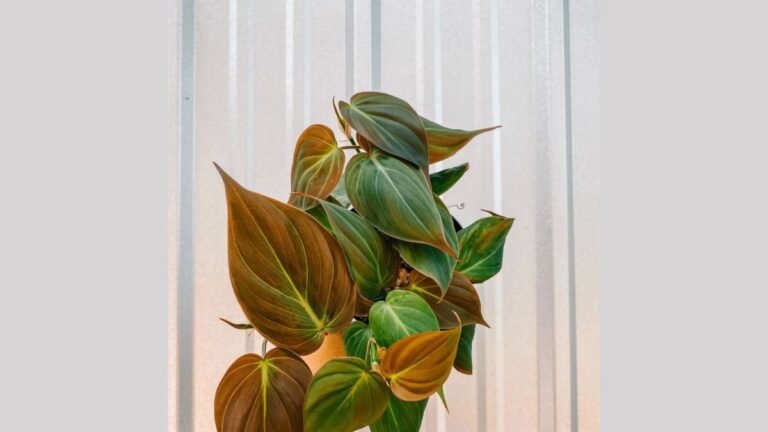Introduction
Philodendron Micans, also known as the Velvet Leaf Philodendron, is one of the most popular houseplants among plant enthusiasts. With its soft, velvety-textured leaves and trailing growth habit, this plant adds elegance and a touch of the tropics to any indoor space. It is an excellent choice for both beginner and experienced plant keepers due to its low-maintenance nature and adaptability.
This article provides an in-depth look at the Philodendron Micans, covering its origin, characteristics, care requirements, propagation, and common issues. A detailed table is also included for quick reference.
Table: Quick Reference for Philodendron Micans
| Feature | Details |
|---|---|
| Scientific Name | Philodendron hederaceum var. hederaceum ‘Micans’ |
| Common Name | Velvet Leaf Philodendron |
| Family | Araceae |
| Origin | Central and South America |
| Growth Habit | Trailing/Vining |
| Mature Size | 12-24 inches (indoor) |
| Leaf Color | Green with a velvety bronze, purple, or red hue |
| Light Requirements | Bright, indirect light; tolerates low light |
| Watering Needs | Moderate; allow topsoil to dry between watering |
| Soil Type | Well-draining, airy soil (peat, perlite, bark) |
| Humidity | High humidity preferred (above 50%) |
| Temperature | 65-80°F (18-27°C) |
| Toxicity | Toxic to pets and humans if ingested |
| Propagation | Stem cuttings in water or soil |
Origins and Natural Habitat
Philodendron Micans is native to the tropical rainforests of Central and South America, where it grows as an epiphytic or terrestrial plant. In the wild, it climbs trees, attaching itself using aerial roots, which help it reach sunlight filtering through the dense canopy.
Distinctive Features
- Velvety Leaves: One of the defining characteristics of Micans is its soft, suede-like foliage. Unlike the glossy leaves of other Philodendron species, Micans leaves have a matte finish with a velvety texture.
- Color Variation: The leaves display a spectrum of colors, ranging from deep green to bronze, purple, or reddish hues, depending on the light conditions.
- Trailing Growth Habit: As a vining plant, Micans grows long, cascading stems, making it ideal for hanging baskets, shelves, or trained up a moss pole.
- Fast Growth Rate: Under optimal conditions, Micans grows rapidly and can reach significant lengths within a few months.
Care Requirements
Light
Philodendron Micans thrives in bright, indirect light. It can tolerate lower light conditions, but its growth may slow down, and the vibrant colors of the leaves may become less pronounced. Direct sunlight should be avoided as it can scorch the delicate foliage.
Watering
Watering should be done when the top 1-2 inches of soil feel dry. Overwatering can lead to root rot, while underwatering may cause the leaves to wilt. Using a moisture meter or simply checking the soil with a finger can help maintain an ideal watering schedule.
Soil
A well-draining, airy soil mix is essential for healthy growth. A good mix consists of:
- Peat or coco coir (for moisture retention)
- Perlite or pumice (for aeration)
- Orchid bark (to improve drainage)
Humidity and Temperature
Philodendron Micans thrives in higher humidity levels (above 50%). If the indoor environment is too dry, using a humidifier, pebble tray, or occasional misting can help maintain moisture.
The ideal temperature range is between 65-80°F (18-27°C). Avoid exposure to cold drafts or sudden temperature drops, which may stress the plant.
Fertilization
A balanced liquid fertilizer, diluted to half strength, should be applied once a month during the growing season (spring and summer). Reduce feeding in the fall and winter when the plant’s growth slows down.
Pruning
Regular pruning helps maintain the plant’s shape, encourages fuller growth, and removes any leggy or yellowing stems. Use clean, sharp scissors or pruning shears to cut just above a leaf node.
Propagation
Philodendron Micans is easily propagated through stem cuttings. Here’s a step-by-step guide:
Method 1: Water Propagation
- Take a cutting with at least one node and one or two leaves.
- Remove any leaves near the node to expose it.
- Place the cutting in a jar of water, ensuring the node is submerged.
- Keep the jar in bright, indirect light and change the water every few days.
- Roots should develop in 2-4 weeks, after which the cutting can be planted in soil.
Method 2: Soil Propagation
- Take a similar stem cutting with a node.
- Dip the cut end in rooting hormone (optional but helpful for faster rooting).
- Plant the cutting in moist, well-draining soil.
- Keep the soil slightly damp and place the pot in a warm, humid environment.
- Roots should establish within a few weeks.
Common Issues and Solutions
Yellowing Leaves
- Cause: Overwatering or poor drainage.
- Solution: Allow the top layer of soil to dry before watering again and ensure the pot has drainage holes.
Leggy Growth
- Cause: Insufficient light.
- Solution: Move the plant to a brighter location with indirect light.
Drooping Leaves
- Cause: Underwatering or extreme temperature changes.
- Solution: Water consistently and keep the plant in a stable environment.
Pests (Spider Mites, Mealybugs, Aphids)
- Cause: Dry conditions and lack of airflow.
- Solution: Wipe leaves with neem oil, use insecticidal soap, or introduce beneficial insects like ladybugs.
Brown Leaf Edges
- Cause: Low humidity or excessive fertilizer.
- Solution: Increase humidity and reduce fertilization frequency.
Uses and Benefits
Philodendron Micans is not only a beautiful decorative plant but also offers several benefits:
- Air Purification: It helps remove toxins such as formaldehyde from indoor air.
- Aesthetic Appeal: Its trailing vines enhance home and office spaces, making them more inviting.
- Easy Maintenance: A great choice for busy individuals or beginners.
Conclusion
Philodendron Micans is an exquisite houseplant with stunning velvet-textured leaves, making it a favorite among plant lovers. With minimal care, it thrives and provides a lush, elegant look to any indoor space. Whether grown in a hanging basket, trained up a moss pole, or propagated for sharing with friends, this plant is a wonderful addition to any plant collection.
By following the guidelines outlined in this article, you can ensure your Philodendron Micans remains healthy and vibrant for years to come!

